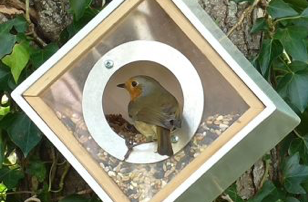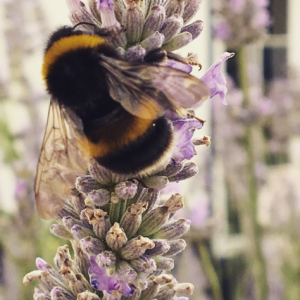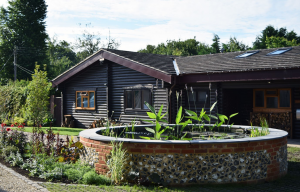
A few weeks ago, Tim and I were planting up a mixed hedge of pretty-much full-size trees to replace a Leylandii hedge for a lovely couple in Benson. When the client was explaining the reason behind the job, Tim and I stood aghast; the hedge (belonging to the neighbouring property) had been removed without warning by developers who were building new houses in the field next door. Our client had literally walked out into his garden one morning to find he no longer had a 20ft hedge screening his garden from the neighbouring field.
Not only had the developers failed to mention that they were removing the hedge, they also seemed unconcerned by the mass exodus of wildlife which occurred once it had been removed. Fortunately, the client is very much a wildlife-friendly gardener and was already planning to increase his woodland planting area to accommodate his new visitors. Phew!
Staying warm in winter
With the noticeable drop in temperature, the time has come to don thermals for work, which must mean, winter is on the way! And the job in Benson got me thinking about how we prepare our gardens to better support wildlife to keep warm and well over winter. Autumn is the time for cutting back growth that is dying off on herbaceous perennials, in beds and borders. If the cold and wet weather put you off venturing into the garden, why not consider leaving the job of cutting back until the spring? This extra foliage can provide additional shelter for insects and small mammals like hedgehogs, who can find protection to hibernate here. If you find this too unsightly, consider tying up bundles of the stems you have removed and leaving them somewhere sheltered and hidden. Small mammals and ladybirds will take shelter in the stems over winter and will be ready and waiting to help you tackle any unwanted pests that arrive in spring.
Wonderful leaf mould
Gathering leaves into piles can generate leaf mould to add nourishment to beds next year. However, If you locate leaf piles around the bottom of shrubs and hedges, this directly benefits the plants (saves you a mulching job next year) and can also provide a safe place for hedgehogs, small mammals, amphibians and insects to over winter.
If you would rather invest in a winter residence for your spiny visitors, why not take a look at our lovely hedgehog igloo available in the Green Art shop (Insert link here).
Don’t forget the birds
Unlike many mammals who reduce their need for food over winter, birds need a good source of food over winter to survive. Now is the time to think about cleaning out those bird feeders, scrubbing and cleaning with a mild disinfectant helps to reduce the risk of the spread of disease. Last time we talked about harvesting apples and other fruit in our gardens. If you have a glut of fruit, why not consider freezing it and you will then have bird food to put out throughout the winter, which will help fruit loving birds like robins, blackbirds and thrushes.
You should also clean out bird boxes before winter sets in as they will then be ready for nesting in spring, you may also find that some birds will use them to roost in on cold nights.

Helpfully, you can also purchase a variety of traditional and contemporary bird tables and bird boxes in our shop here. https://greenart.co.uk/product-category/wildlife-garden/
Hibernating insects
The temptation at this time of year is to have a good cut back of plants like ivy. But, did you know that mature ivy can help provide a home for hibernating insects and its flowers provide nourishment to late flying pollinators and ivy berries provide food for birds in late winter? Yet another plant that it is worth holding off on pruning till the spring!
When I was doing a bit of research for this blog I found out that queen bees then hibernate in holes in banks or under long grass during winter. Something to be aware of if you are digging mulch into beds during autumn!

Wildlife in water
And last, but not least, I need to mention ponds as many of George’s designs, like this one here in Crowmarsh Gifford, feature water in some form or other.

For inhabited ponds, the biggest risk to the wildlife within is a full freeze of the surface. Floating a ball in the pond over winter can help reduce the risk of this happening. However, if your pond does freeze, the way to help defrost it is to hold a pan of boiling water onto the surface of the ice which will help melt a hole in it. And, if possible, leave logs stacked somewhere near your pond to provide a safe resting place for frogs and toads.
As you can see, the nice thing about being wildlife-considerate at this time of year is that it reduces your Autumn gardening workload a little which has to be a good thing! And the time you save, you could use to begin to get ahead for Christmas instead. The wildlife items I mentioned above, make great Christmas presents for friends and family too, why not take a look
https://greenart.co.uk/product-category/wildlife-garden/
That’s all for now folks! I’ll be back soon to talk about garden jobs for winter.
Warm regards,
Jenny
New products in the GreenArt shop
We at GreenArt can provide help at any level
From planning a wildlife garden, building hides, constructing ponds and streams, creating paths and planting trees and shrubs.








